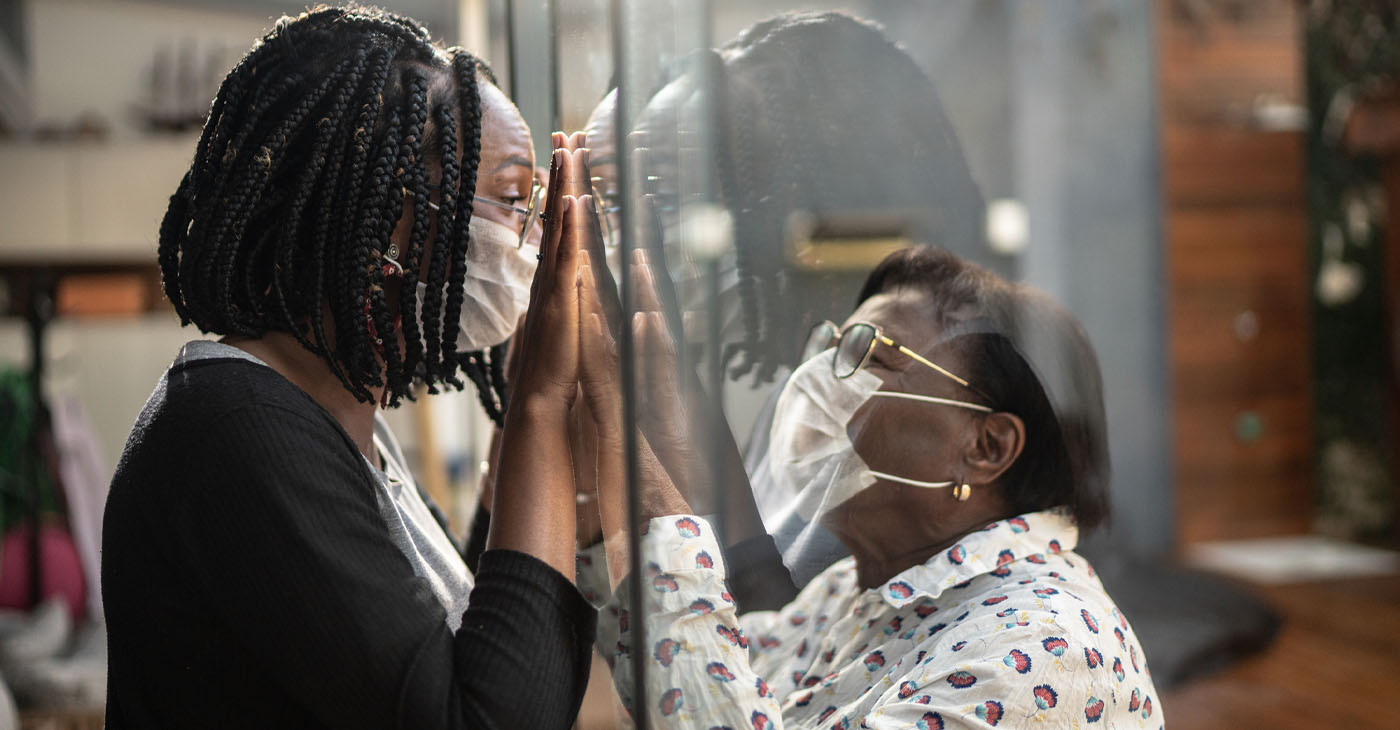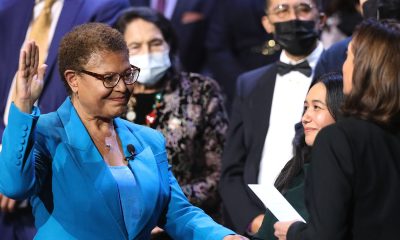Coronavirus
Officials Urge Black Community to Take COVID Shot
The number of cases in California dropped by 31% over 14 days leading up to January 22, according to the New York Times California Coronavirus Map and Case Count. The most recent peak in California was January 12 with almost 46,000 cases reported that day. On January 22, California reported about 25,000 new cases, almost half the number of cases reported 10 days earlier.

COVID-19 hospitalizations are starting to decrease in California, but that decline does not mean the pandemic is over, state health officials warn.
The number of cases in California dropped by 31% over 14 days leading up to January 22, according to the New York Times California Coronavirus Map and Case Count. The most recent peak in California was January 12 with almost 46,000 cases reported that day. On January 22, California reported about 25,000 new cases, almost half the number of cases reported 10 days earlier.
Health professionals representing “Vaccinate All 58,” a statewide vaccine safety and equity campaign Gov. Gavin Newsom launched, joined a Zoom press briefing with California Black Media organized in partnership with the Center at Sierra Health Foundation.
The event was held to discuss the next steps for distribution of the vaccine. The news conference also addressed changes that must be made — and misconceptions that must be disproved — to encourage a large cross section of reluctant African Americans to feel comfortable enough to take the vaccine.
“We have stepped up our support to hospitals, and we are saving lives,” California Surgeon General Dr. Nadine Burke Harris said at the briefing. “And we are optimistic that this curve is flattening and that the pace of vaccination is accelerating. We will get through this together.”
Part of getting through the pandemic together is for everyone to get vaccinated, Burke Harris explained.
“Our big goal is to turn vaccines into vaccinations,” she said. “So as our state continues to ramp up the rollout of our vaccines, we are continually committed to a fair and equitable allocation and distribution process. Equity has been central to California’s vaccine strategy.”
Equitable distribution has proven to be difficult. In a study conducted last year by The Undefeated and the Kaiser Family Foundation (KFF), half of Black U.S. adults surveyed said they are not planning to take the vaccine. Several other independent surveys have echoed that report’s findings. This prompted the California Dept. of Public Health (CDPH) to turn to community partnerships to build trust of the vaccine in California’s African American communities.
“We are partnering with 160 or so community-based organizations,” CDPH spokesperson Darrel Ng said. “We’re not quite ready to announce them yet, but they will be all over the state.”
Speakers participating in the briefing said outreach will be conducted through local organizations, including nonprofits and churches. Shantay R. Davies-Balch, president and CEO of the BLACK Wellness and Prosperity Center, described one recent effort.
She said a survey was held in the Fresno community to obtain data on how to move forward with programming that will be effective in raising awareness about the COVID-19 vaccine.
Burke Harris said the state is laser-focusing its efforts to reach communities that are disproportionately impacted by COVID-19, particularly Blacks and Latinos.
In Los Angeles, Mayor Eric Garcetti, County Supervisor Holly Mitchell and two city councilmen representing South Los Angeles held a conference at St. John’s Well Child & Family Center to encourage those distrustful of the vaccine to get vaccinated, especially since coronavirus infections disproportionately affect the South L.A. community, made up predominantly of Black and Latino residents.
Currently, in the state of California, vaccines have been distributed to healthcare providers and are now available to adults 65 and older. Soon, the state will launch a website where people can register with a new system that will notify them when they are eligible to receive the vaccine.
Regarding the vaccine’s safety, Dr. Elaine Batchlor, CEO of Martin Luther King Jr Community Hospital in Los Angeles County, explained that both the Pfizer-BioNTech and Moderna vaccines went through various trials and have been authorized by the Food and Drug Administration.
She also explained that the vaccine trials incorporated a diverse pool of people, including communities of color and older adults. She noted that an African American woman, Dr. Kissmekia Corbett, was one of the leading researchers on the Moderna vaccine.
“I know that that many people in our community are hesitant and worried about safety, so I want to stress that these vaccines have been held to the same safety standards as all vaccines,” she said.
The vaccines both require two doses. The doses of the Moderna vaccine must be given 28 days apart and the Pfizer vaccine must be given 21 days apart. When the vaccine is available to the broader public, people will be able to receive the vaccine from their primary care provider. If someone does not have a primary care provider, the County Dept. of Public Health will direct them to the nearest testing center that administers the vaccine.
Davies-Balch noted that “Vaccinate all 58” is working to ensure that the vaccination clinics are accessible to everyone. But the date on which the vaccine will be available to everyone is still not known.
In the meantime, Burke Harris urged people to continue to follow the “four w’s”: wear a mask, wash hands, watch your distance and wait to see your friends and loved ones.
Even those who get vaccinated must follow physical distancing protocols because of the uncertainty around transmission, the experts say. Although the vaccine prevents those infected from getting ill, there are still studies being conducted to see if it prevents transmission. This means that someone who has been vaccinated could possibly carry the virus to someone who hasn’t been, exposing them to COVID-19. Although Batchlor believes the vaccination prevents transmission, she explained that data still needs to be supplied to support that theory.
For now, the goal is to swiftly administer as many vaccinations as possible, she said.
“Once we reach community immunity, we will be ready to throw all of our masks in the trash and go back to our normal activities and interactions,” Batchlor added.
Activism
ESSAY: Technology and Medicine, a Primary Care Point of View
The COVID-19 pandemic, for example, restricted millions of people to their homes, which required reliance on the internet for communication and information. Personal internet searches became essential to understanding information about COVID, human physiology, symptoms, and keeping up with vaccine updates. However, this increase in independent online research resulted in people accessing more misinformation circulating on the internet. This posed a challenge for medical providers trying to treat patients according to research-based guidelines. With so much information within reach, it was difficult for providers to help their patients distinguish between legitimate evidence-based sources and opinion, speculation, and fabrication.

Dr. Adia Scrubb
Special to California Black Media Partners
Technology has enhanced communication between medical professionals and patients; improved patient care management; and eased access to care and information, benefiting both patients and medical clinicians.
However, despite the ease and many conveniences these patient care improvements have ushered in, adequate patient care still includes physician supervision, examinations, and interaction, which present challenges for keeping up with demands on the healthcare system and accurate patient education.
Technology has made more educational resources available at our fingertips, and it has created independence for those who want to know more about their bodies.
The COVID-19 pandemic, for example, restricted millions of people to their homes, which required reliance on the internet for communication and information. Personal internet searches became essential to understanding information about COVID, human physiology, symptoms, and keeping up with vaccine updates. However, this increase in independent online research resulted in people accessing more misinformation circulating on the internet. This posed a challenge for medical providers trying to treat patients according to research-based guidelines. With so much information within reach, it was difficult for providers to help their patients distinguish between legitimate evidence-based sources and opinion, speculation, and fabrication.
Nowadays, patients continuously arm themselves with medical information and challenge clinicians with the research they gather from internet sources to advocate for themselves and their care. This often leaves medical professionals with the complex task of navigating challenging discussions, pointing patients to validated and verified medical information, and following evidence-based medical guidelines for treatment.
Reviewing information before an appointment can certainly make an office visit much more productive, but it is essential to acknowledge the possible bias and limitations of internet searches. Consideration of the author, source, and date of the information may help determine its validity.
Furthermore, simply asking medical professionals for their preferred patient information resources will direct patients to safe and validated information that is in line with standards of care practices. This can help patients better understand the recommendations from their doctors and streamline their internet searches.
Access to individual online medical record information, such as blood tests, MRI reports, and office visit notes, has been a significant expansion of technology in medicine. This digitization of medical information enables and positions patients to take a leading role in managing their care. What used to be multiple sheets of paper in a large file folder is now a click away at any time. Despite these benefits, instant access can be overwhelming for both patients and medical providers, especially since patients, in many instances, can receive their test results online before the physician has had the opportunity to review them.
Patients may review the office visit notes or their lab results out of context or misinterpret information, which can lead to anxiety, confusion, and fear. Clinicians are put in a difficult position when they are not able to suddenly break away from their scheduled office visits to reassure an unscheduled patient about their results and next steps.
Medical providers have tools to assist with identifying sensitive results that need urgent review, and efforts are made to notify anxious patients as soon as possible. However, a patient can be proactive in scheduling a follow-up visit ahead of time to review results with their provider specifically. This can help patients avoid the stress of suddenly trying to get a hold of their doctor when dealing with unclear or concerning results. Normal test results often don’t require explanation, but allowing several days for your provider to work through hundreds of test results before sending messages requesting clarification will help medical professionals prioritize their responses to test results based on medical urgency.
Technological improvements such as online messaging and video/telephone appointments have made access to care much easier both for patients and clinicians. Telephone and video visits have been especially beneficial for patients who are elderly, disabled, or do not have access to transportation. However, the increase — and ease of — access has created much higher demand for physician time both during and outside of the office visit. Test results, patient messages, insurance forms, emails, and medication requests are all pouring in while providers conduct their daily scheduled appointments. Thus, very little time is left in the day for a clinician to respond to every email, fill out every form, and review every lab result when they are responsible for 1,800 or more patients.
This situation, unfortunately, creates a perceived delay in response in a culture where an instant response is expected from messaging and phone calls. But the reality is that the medical provider is constantly playing catch up to thousands of inquiries due to the around-the-clock online access patients now have.
Patients can make the most of their experience and their physician’s time by taking the time to learn their physician’s communication preferences. Despite the multiple modalities of access (telephone, email, video, in-person), a medical provider will have a preferred method of communication with their patients. Some may ask their patients to make an appointment to explain a complex topic, instead of responding to multiple messages. Others may prefer to communicate via phone call if they have to deliver bad news.
There will likely be more medical providers who prefer to communicate only through email or video appointments as remote work becomes more common. If a patient’s communication preferences align with their physician’s preferences, it will create a stronger patient-doctor relationship and foster more effective and impactful communication.
The expansion of technology in medicine has fostered better collaboration, communication, and education between patients and their medical professionals. Combining electronic resources with rapport, mutual respect, and trust for providers will help patients navigate this new landscape of healthcare.
About the Author
Dr. Adia Scrubb, MD, MPP, is a Board-Certified Family Medicine Physician currently practicing in Solano County.
Alameda County
After Years of Working Remotely, Oakland Requires All City Employees to Return to Office by April 7
City Administrator Jestin Johnson recently told city unions that he is ending Oakland’s telecommuting program. The new policy will require employees to come to work at least four days a week. These new regulations go into effect on Feb. 18 for non-union department heads, assistant and deputy directors, managers, and supervisors. All other employees must be back at work by April 7.

By Post Staff
The City Oakland is requiring all employees to return to the office, thereby ending the telecommuting policy established during the pandemic that has left some City Hall departments understaffed.
City Administrator Jestin Johnson recently told city unions that he is ending Oakland’s telecommuting program. The new policy will require employees to come to work at least four days a week.
These new regulations go into effect on Feb. 18 for non-union department heads, assistant and deputy directors, managers, and supervisors. All other employees must be back at work by April 7.
The administration may still grant the right to work remotely on a case-by-case basis.
In his memo to city unions, Johnson said former President Joe Biden had declared an end to the pandemic in September 2022, and that since then, “We have collectively moved into newer, safer health conditions.”
Johnson said “multiple departments” already have all their staff back in the office or workplace.
The City’s COVID-era policy, enacted in September 2021, was designed to reduce the spread of the debilitating and potentially fatal virus.
Many cities and companies across the country are now ending their pandemic-related remote work policies. Locally, mayoral candidate Loren Taylor in a press conference made the policy a central issue in his campaign for mayor.
City Hall reopened for in-person meetings two years ago, and the city’s decision to end remote work occurred before Taylor’s press conference.
At an endorsement meeting last Saturday of the John George Democratic Club, mayoral candidate Barbara Lee said she agreed that city workers should return to the job.
At the same time, she said, the city should allow employees time to readjust their lives, which were disrupted by the pandemic, and should recognize individual needs, taking care to maintain staff morale.
The John George club endorsed Lee for Mayor and Charlene Wang for City Council representative for District 2. The club also voted to take no position on the sales tax measure that will be on the April 15 ballot.
Bay Area
Authorities Warn: There’s a COVID Surge in California
According to data estimates by the Centers for Disease Control and Prevention (CDC), the coronavirus in California’s wastewater has spiked for eight consecutive weeks. Hospitalizations and emergency room visits have also increased since the rise of the new subvariants. Over the last month, Los Angeles County experienced an average of 389 hospital patients per day that tested positive for the coronavirus. The FLiRT subvariants such as KP.3.1.1. Made up over 2% of coronavirus samples nationwide, an increase of more than 7% last month.

By Bo Tefu, California Black Media
California is experiencing a COVID-19 surge this summer, experts warn, as numbers of infections increased for the third month this year.
State public health authorities attribute the summer COVID surge to more infectious subvariants that have emerged as the coronavirus evolves.
Dr. Elizabeth Hudson, regional chief of infectious disease at Kaiser Permanente Southern California, stated that subvariants of COVID-19 called FLiRT increased in recent months, particularly one named KP.3.1.1 that has become the most common strain in the country.
Dr. Peter Chin-Hong, an infectious diseases expert at UC San Francisco, said that the subvariant KP.3.1.1 seems most adept at transmission.
“The subvariant is the one that people think will continue to take over, not only in the United States, but … around the world,” Chin-Hong said.
According to data estimates by the Centers for Disease Control and Prevention (CDC), the coronavirus in California’s wastewater has spiked for eight consecutive weeks. Hospitalizations and emergency room visits have also increased since the rise of the new subvariants. Over the last month, Los Angeles County experienced an average of 389 hospital patients per day that tested positive for the coronavirus. The FLiRT subvariants such as KP.3.1.1. Made up over 2% of coronavirus samples nationwide, an increase of more than 7% last month.
The majority of the people who tested positive for COVID-19 complained of a sore throat and a heavy cough. Risk factors that can increase the illness include age, underlying health issues, and vaccine dosage.
Health experts stated that the demand for the COVID-19 vaccine has increased in Northern California. However, people are having a hard time getting the vaccine due to the increasing number of cases.
-

 Activism4 weeks ago
Activism4 weeks agoOakland Post Endorses Barbara Lee
-

 Activism4 weeks ago
Activism4 weeks agoOakland Post: Week of April 2 – 8, 2025
-

 Activism2 weeks ago
Activism2 weeks agoOakland Post: Week of April 9 – 15, 2025
-

 #NNPA BlackPress3 weeks ago
#NNPA BlackPress3 weeks agoTrump Profits, Black America Pays the Price
-

 #NNPA BlackPress3 weeks ago
#NNPA BlackPress3 weeks agoHarriet Tubman Scrubbed; DEI Dismantled
-

 #NNPA BlackPress3 weeks ago
#NNPA BlackPress3 weeks agoTrump Targets a Slavery Removal from the National Museum of African-American History and Culture
-

 #NNPA BlackPress3 weeks ago
#NNPA BlackPress3 weeks agoNew York Stands Firm Against Trump Administration’s Order to Abandon Diversity in Schools
-

 #NNPA BlackPress4 weeks ago
#NNPA BlackPress4 weeks agoLawmakers Greenlight Reparations Study for Descendants of Enslaved Marylanders


























































